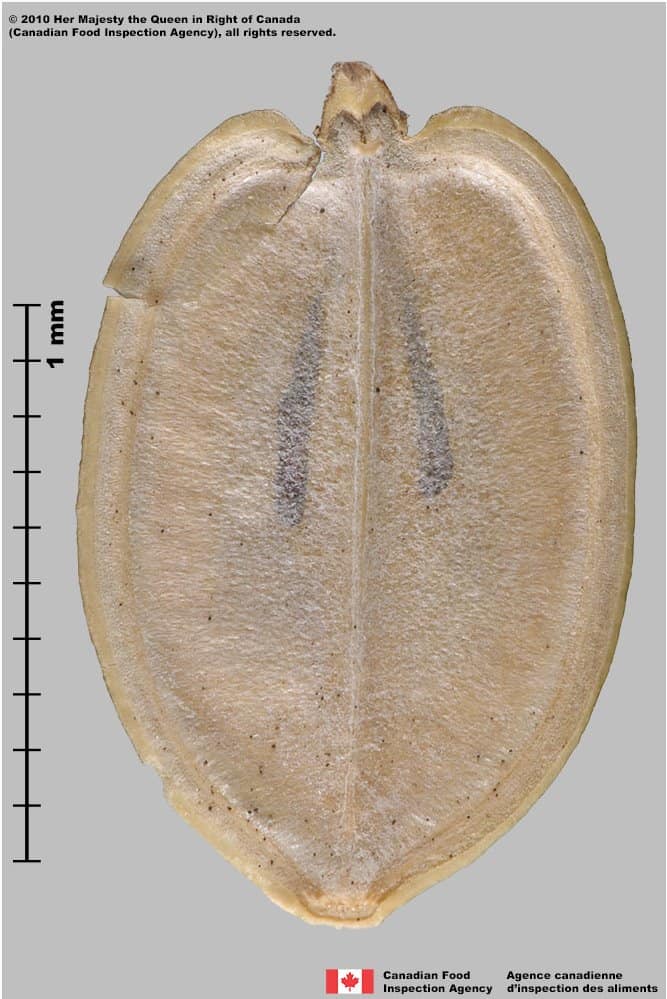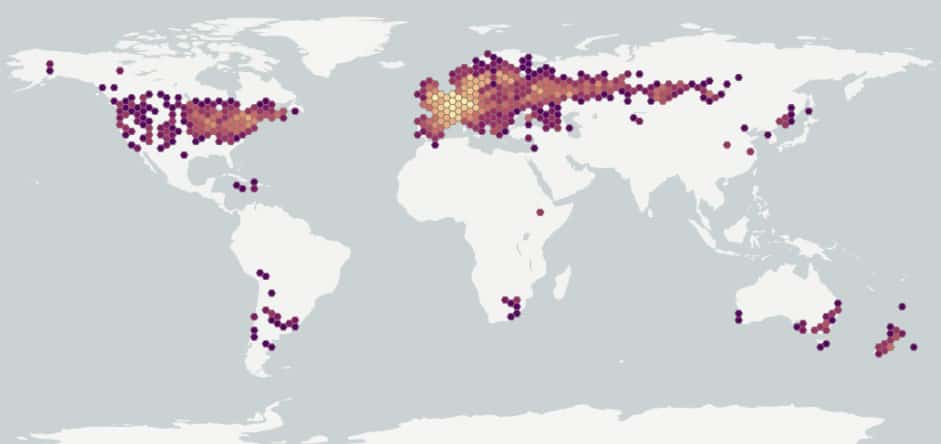Pastinaca sativa subsp. sylvestris
Overview
Aperçu
Regulation :
Remarques Réglementation:
- CFIA Weed Seeds Order - Class 3: Secondary Noxious Weed Seeds
Regulation Notes:
Distribution :
Répartition :
Native to Europe and western temperate Asia (USDA-ARS 2022). Naturalized in southern Africa, eastern Asia, Australia, New Zealand, North America and parts of South America (Cain et al. 2010; USDA-ARS 2022). It is widespread in the United States, except in the southeastern states and Hawaii (Cain et al. 2010). Occurs in all Canadian provinces and territories except Nunavut (Brouillet et al. 2010+).
Habitat and Crop Association :
Habitat et Cultures Associées :
Pastures, gardens, old fields, riverbanks, beaches, sloughs, forest clearings, railway embankments, roadsides, field edges and disturbed areas (Darbyshire 2003; Cain et al. 2010).
Economic Use, cultivation area, and Weed Association :
Utilisation économique, zone de culture et association de mauvaises herbes :
Duration of Life Cycle :
Durée du cycle vital:
Biennial
Dispersal Unit Type :
Type d’unité de dispersion :
Schizocarp, divided into 2 mericarps
General Information
RENSEIGNEMENTS GÉNÉRAUX
Pastinaca sativa subsp. sylvestris is believed to be naturalized from cultivation and possibly from seed contamination (Cain et al. 2010). Pastinaca sativa subsp. sativa (cultivated parsnip) was first documented in Canada in 1612 and by the late-1700s, this species was found established around historical European settlements in eastern Canada (Cain et al. 2010).
P. sativa subsp. sylvestris seeds have an underdeveloped embryo and a reduced dormancy when they are fresh, and have a higher germination rate the following Spring (Cain et al 2010). It is common for mericarps to develop without seeds (Cain et al 2010).
Plant tissues contain toxic furanocoumarins, concentrated in the flowers and the oil ducts of the seeds. These chemicals can cause burns when skin is or eyes are exposed to UV radiation or sunlight in both humans and livestock (Cain et al 2010).
.
Pastinaca sativa infestation (Leslie J. Mehrhoff, University of Connecticut, Bugwood.org)
Identification
Identification
-
Mericarp
Size
- Mericarp length*: 3.9 – 6.0 mm; width: 2.6 – 4.5
*Note: minimum and maximum of 10 mericarps in a normal range of this species using image measurement (ISMA 2020)
Shape
- Mericarp is oval-shaped, flattened
Surface Texture
- Mericarp is slightly wrinkled with a winged edge
- One side (outer side) has three thin, curved, longitudinal ridges near the centre of the mericarp
- The other side (inner side) has one central ridge
Colour
- Mericarp is dull, straw-yellow or brown with reddish oil ducts
Other Features
Mericarp end with style remnant
- Style remnant is short and triangular shaped
- A piece of connective tissue from between the mericarps may be attached to the style remnant
- Shallow notch or no notch along the edge of the mericarp at the style remnant
Other features
- The schizocarp is comprised of two connected mericarps
- One side (outer side) of each mericarp has four linear oil ducts between the surface ridges extending almost its full length
- The other side (inner side) of each mericarp has two shorter oil ducts on either side of the central ridge

Pastinaca sativa subsp. sylvestris (wild parsnip) mericarps





-
Seed
Size
- Seed is generally 2/3 of the mericarp size
Shape
- Seed is oval shaped, flattened
- Oil ducts may be attached to the seed, or be removed with the fruit wall
Surface Texture
- Seed is smooth
Colour
- Seed is greenish coloured
Other Features
- Seed coat thin, transparent, adhering to the fruit wall
-
Embryo
Size
- Embryo is a rudimentary size
Shape
- Embryo is linear
Endosperm
- Endosperm is soft and oily, translucent light green coloured
Other Features
- Embryo is in a basal position
Identification Tips
CONSEILS POUR L’IDENTIFICATION
Several genera within the Apiaceae have straw yellow coloured fruits that are flattened with longitudinal reddish oil ducts, e.g. Heracleum, Aethusa, Angelica and Pastinaca. Pastinaca sativa subsp. sylvestris mericarps can be distinguished by prominent surface ridges, small or no notch at the end with the style remnant and long, linear oil ducts.

Pastinaca sativa subsp. sylvestris (wild parsnip) mericarp





Additional Botany Information
AUTRES RENSEIGNEMENTS BOTANIQUES
Flowers/Inflorescence
- Yellow flowers are arranged in compound umbels; flowers infrequently white (Cain et al. 2009)
Vegetative Features
- Stems (flowering stalks) are grooved, hollow, and 40 – 200 cm in height (Cain et al. 2009)

Pastinaca sativa inflorescence (Leslie J. Mehrhoff, University of Connecticut, Bugwood.org)







Similar Species
ESPÈCES SEMBLABLES
Similar species are based on a study of seed morphology of various species, and those with similar dispersal units are identified. The study is limited by physical specimen and literature availability at the time of examination, and possibly impacted by the subjectivity of the authors based on their knowledge and experience. Providing similar species information for seed identification is to make users aware of similarities that could possibly result in misidentification.
Heracleum sphondylium subsp. montanum (Schleich. ex Gaudin) Briq. (cow parsnip)
H. sphondylium subsp. montanum mericarps are larger (length*: 6.6 – 12.5 mm; width: 4.9 – 8.6) than P. sativa subsp. sylvestris. The oil ducts of H. sphondylium subsp. montanum mericarps reach almost to the opposite end, and the ridges between the oil ducts are not as prominent as P. sativa subsp. sylvestris mericarps.
*Note: minimum and maximum of 20 mericarps in a normal range of this species using image measurement (ISMA 2020)
Click to select species
Cliquez pour sélectionner les espèces

Heracleum sphondylium subsp. montanum
Comparison Window
Fenêtre de comparaison
MAIN SPECIES
ESPÈCES PRINCIPALES
Pastinaca sativa subsp. sylvestris

Pastinaca sativa subsp. sylvestris
Apiaceae
Pastinaca sativa subsp. sylvestris (wild parsnip) mericarps
MAIN SPECIES
ESPÈCES PRINCIPALES
Pastinaca sativa subsp. sylvestris

Pastinaca sativa subsp. sylvestris
Apiaceae
Pastinaca sativa subsp. sylvestris (wild parsnip) mericarps
MAIN SPECIES
ESPÈCES PRINCIPALES
Pastinaca sativa subsp. sylvestris

Pastinaca sativa subsp. sylvestris
Apiaceae
Pastinaca sativa subsp. sylvestris (wild parsnip) mericarp
MAIN SPECIES
ESPÈCES PRINCIPALES
Pastinaca sativa subsp. sylvestris

Pastinaca sativa subsp. sylvestris
Apiaceae
Pastinaca sativa subsp. sylvestris (wild parsnip) seed head
MAIN SPECIES
ESPÈCES PRINCIPALES
Pastinaca sativa subsp. sylvestris

Pastinaca sativa subsp. sylvestris
Apiaceae
Pastinaca sativa subsp. sylvestris (wild parsnip) mericarps, inner face (L) and outer face (R)
SIMILAR SPECIES
ESPÈCES SEMBLABLES
Heracleum sphondylium subsp. montanum

Heracleum sphondylium subsp. montanum
Apiaceae
Cow parsnip (Heracleum sphondylium subsp. montanum) mericarps
SIMILAR SPECIES
ESPÈCES SEMBLABLES
Heracleum sphondylium subsp. montanum

Heracleum sphondylium subsp. montanum
Apiaceae
Cow parsnip (Heracleum sphondylium subsp. montanum) mericarps
SIMILAR SPECIES
ESPÈCES SEMBLABLES
Heracleum sphondylium subsp. montanum

Heracleum sphondylium subsp. montanum
Apiaceae
Cow parsnip (Heracleum sphondylium subsp. montanum) mericarp, outer side
SIMILAR SPECIES
ESPÈCES SEMBLABLES
Heracleum sphondylium subsp. montanum

Heracleum sphondylium subsp. montanum
Apiaceae
Cow parsnip (Heracleum sphondylium subsp. montanum) mericarp, inner side
Need ID Help?
Besoin d’aide pour l’identification?
Reference(s)
Référence(s)
Brouillet, L., Coursol, F., Meades, S. J., Favreau, M., Anions, M., Bélisle, P. and Desmet, P. 2010+. VASCAN, the database of vascular plants of Canada. http://data.canadensys.net/vascan/ Accessed June 01, 2021.
Cain, N., Darbyshire, S. J., Francis, A., Nurse, R. E. and Simard, M. J. 2010. The Biology of Canadian weeds. 144. Pastinaca sativa L. Canadian Journal of Plant Science 90: 217-240.
Darbyshire, S. J. 2003. Inventory of Canadian Agricultural Weeds. Agriculture and Agri-Food Canada, Research Branch. Ottawa, ON.
Global Biodiversity Information Facility (GBIF) Secretariat. 2022. https://doi.org/10.15468/39omei Accessed via https://www.gbif.org/species/8262702 Accessed December 29, 2022.
Government of Canada (GC). 2016. Canadian Weed Seeds Order. https://laws-lois.justice.gc.ca/eng/regulations/SOR-2016-93/page-2.html (English) https://laws-lois.justice.gc.ca/fra/reglements/DORS-2016-93/page-2.html (French)
International Seed Morphology Association (ISMA). 2020. Method for Seed Size Measurement. Version 1.0. ISMA Publication Guide. https://www.idseed.org/authors/details/method_for_seed_size_measurement.html
U.S. Department of Agriculture-Agricultural Research Services (USDA-ARS). 2022. Germplasm Resources Information Network – (GRIN), https://npgsweb.ars-grin.gov/gringlobal/taxon/taxonomysimple.aspx Accessed May 12, 2022.
U.S. Department of Agriculture-Natural Resources Conservation Service (USDA-NRCS). 2022. The PLANTS Database. National Plant Data Team, Greensboro, NC USA. http://plants.usda.gov Accessed December 29, 2022.




